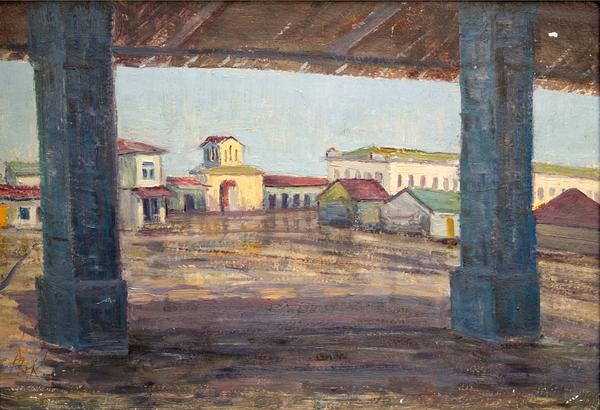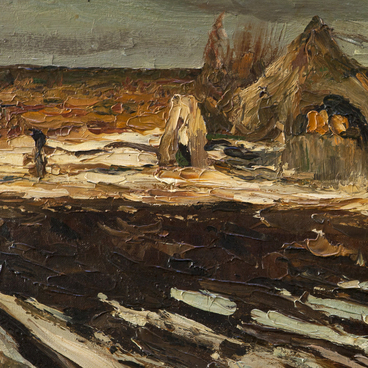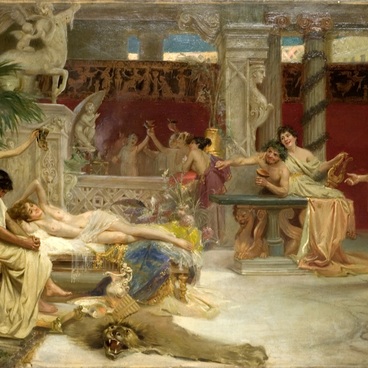Vladimir Klyonov was the first professional artist in Stavropol. He was born in 1896 to a large family of a cobbler. In 1914, Klyonov left for Moscow where he entered the private school of Fyodor Rerberg. He had to interrupt his classes during the First World War and the Civil War in which Klyonov participated. In 1924, he entered the 1st Leningrad Nikolai Chernyshevsky Art College and graduated from it four years later.
In 1928, Vladimir Klyonov returned to Stavropol. In his hometown, he did very much for professional artists to have the opportunity to train: he ran studios, opened and managed an art school, worked as a member of the board and exhibition committee of the regional organization of the Union of Artists of the RSFSR.
But Klyonov’s main contribution to the art of Stavropol Krai was in the formation of the Stavropol School of Landscape Painting. In it, the artist laid the foundations of the chamber landscape and landscape sketch. Back in the pre-revolutionary period, Klyonov traveled a lot: he visited Petrograd and the city’s close vicinities, Georgia, the Caspian Sea and the Black Sea coast. He would bring a huge number of sketches from each trip — the earliest one is dated 1914. Those were urban and nature views, mountain scenes and marines, genre scenes. Even in the early years, every sketch by Klyonov, despite the chamber format and plein-air execution, was a complete and independent work with an accurate artistic image.
Over time, Stavropol and its environs became Klyonov’s main love, as well as small towns and villages in the region. Stavropol Steppe and city courtyards, southern night and sunset sky, frosty days and steaming hot middays — the artist was interested in the nuances of space and lighting effects, the textured tangibility of shapes and the elusive mood of the changing nature. In his sketch Stavropol. The Marketplace the artist used an unusual point of view — from inside the merchants’ rows. In the distance a two-storey building of the Gostiny Dvor (Guest House) can be seen where the Stavropol Museum of Local History is now located. It was then that the warehouses built of the local shell stone disappeared, and the trading rows themselves were pulled down. The patriarchal character of old Stavropol only remained in the paintings, which now became documents of the historic period.
In 1928, Vladimir Klyonov returned to Stavropol. In his hometown, he did very much for professional artists to have the opportunity to train: he ran studios, opened and managed an art school, worked as a member of the board and exhibition committee of the regional organization of the Union of Artists of the RSFSR.
But Klyonov’s main contribution to the art of Stavropol Krai was in the formation of the Stavropol School of Landscape Painting. In it, the artist laid the foundations of the chamber landscape and landscape sketch. Back in the pre-revolutionary period, Klyonov traveled a lot: he visited Petrograd and the city’s close vicinities, Georgia, the Caspian Sea and the Black Sea coast. He would bring a huge number of sketches from each trip — the earliest one is dated 1914. Those were urban and nature views, mountain scenes and marines, genre scenes. Even in the early years, every sketch by Klyonov, despite the chamber format and plein-air execution, was a complete and independent work with an accurate artistic image.
Over time, Stavropol and its environs became Klyonov’s main love, as well as small towns and villages in the region. Stavropol Steppe and city courtyards, southern night and sunset sky, frosty days and steaming hot middays — the artist was interested in the nuances of space and lighting effects, the textured tangibility of shapes and the elusive mood of the changing nature. In his sketch Stavropol. The Marketplace the artist used an unusual point of view — from inside the merchants’ rows. In the distance a two-storey building of the Gostiny Dvor (Guest House) can be seen where the Stavropol Museum of Local History is now located. It was then that the warehouses built of the local shell stone disappeared, and the trading rows themselves were pulled down. The patriarchal character of old Stavropol only remained in the paintings, which now became documents of the historic period.



